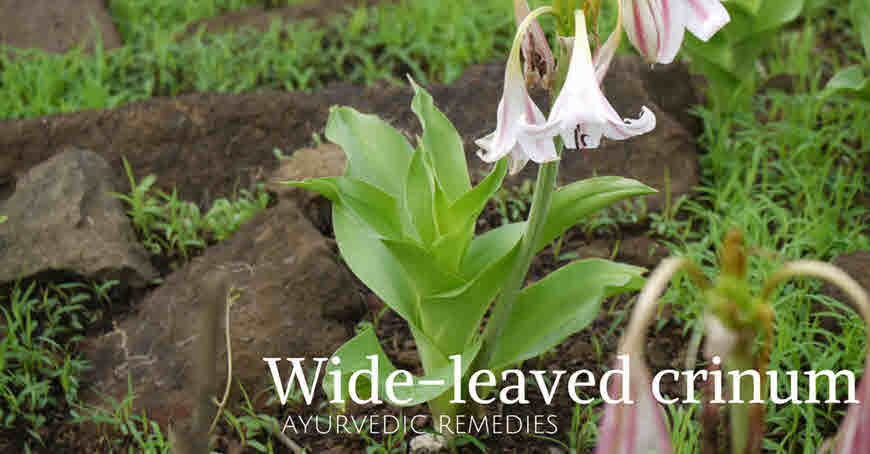Crinum latifolium is grown as ornamental plant due to its flowers and beautiful appearance. This plant is used for medicinal purpose across many countries. In Asia there are about seventeen species of Crinum. It is distrusted in tropical areas and found in Sri Lanka, Southeast Asia. Malaysia, Tropical Asia, Africa, Vietnam, China and India. In Northern region of India, it is known as Sudarshan or Sukhdarshan. This plant flowers and fruiting occurs in months of June to August.

Botanical name: Crinum latifolium L. SYNONYM- C. defixum;C. asiaticum;C. bracteatum;C. toxicarium
Family: Amaryllidaceae
Vernacular names
Sanskrit: Madhuparnika, Vrishakarni Bengali: Sukhdarshan Tamil: Vishamungil Trade name: Wide-leaved crinum. Siddha: Vishamoongil
English: Poison bulb.
Plant description
A stout herb of 40-60cm in height, with bulb-form trunk (like big onion) of diameter 10cm or more;leaves around root and have linear form of 60-90cm in length, 5-
11cm in width, with parallel veins and slightly waved margins;leaf blade wide;Bundle of flowers rise from one main pedicle and form a halo of 30-60cm in length;white fragrant 10-20-flowered umbels;flower has form of funnel, with 6 stamen and 1 stigma.
Chemical composition of Plant
Various parts of the plant contains following:
Glucans, organic acids, saponin, aminoacids, alkaloids.
Glucans: glucan A and B.
Aminoacids: phenylalanine, L-leucin, DL-valin, L-arginin monohydrochloride.
Alkaloids: latisolin, latisodin, Ambellin, 11-0-acetylambellin, 11-0 acetyl 1, 2-ß epoxyambellin, crinafolin, crinafolidin, lycorin, epilycorin, epipancrassidin, 9-0-demethylhomolycorin, lycorin-1, 0-glucosid, pratorin (hippadin), pratorinin, pratorimin, pratosin, beladin, latindin, latifin
Traditional Medicinal uses
Sudarshan(Crinum latifolium) is a medicinal herb that is used from time immemorial. The leaves of the plant are non-toxic and has anti-inflammatory (swelling reducing), analgesic (pain relieving), antitumor, immune stimulating, anti-bacterial, anti-fungal effects, uterine fibroids, detoxification and tissue regeneration activities. The bulb is said to be poisonous.
For the medicinal purpose the bulb and leaves are used.
- The paste of leaves or bulb are applied externally for medicinal purpose.
- The leaf juice is used in earache. The leaves are heated and then ground to extract juice. Four drops of this juice is used as ear drop.
- For swelling, pain, sprain, inflammation of joints and inflamed toes, fingers the heated leaves are tied at affected body part.
- Roasted bulbs are applied for discharge of pus.
- Crushed and roasted bulbs are used as rubefacient in rheumatism.
- In Ayurvedic medicine the plant extract is used in the treatment of allergic conditions. It proved effective probably due to the presence of glucan A and phophatidyllycorine.
- The leaves juice is applied topically on skin diseases and on piles to reduce pain and swelling.
- Poultice of heated, pounded, fresh bulb is used to relieve pain in bones and rheumatism.